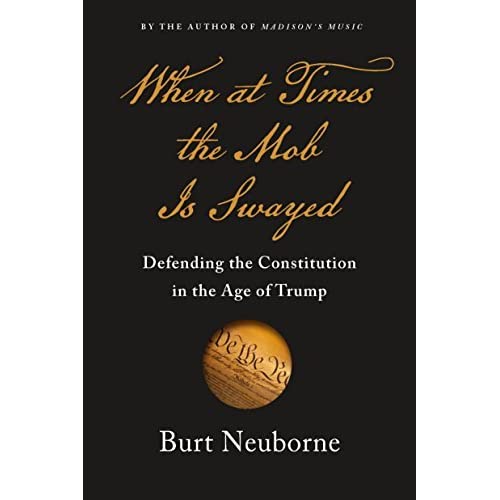When At Times the Mob is Swayed
A Citizen’s Guide to Defending Our Democracy by Burt Neuborne
As National Legal Director of the American Civil Liberties Union, Neuborne has been involved in litigation cases from school boards to every President since Lyndon Johnson with the focus on taking on government officials who appeared to violate Constitutional law. This book highlights how President Donald Trump is the epitome of each official he has ever fought against, but it also demonstrates how he has been able to manipulate the emotions of a broken system. He discusses how this country’s “constitutional brakes” has turned from one that used to honor the constitution to become an angry mob. This is primarily due to, as Neuborne writes, “a charismatic, authoritarian president named Donald Trump, whose genius for creating scapegoats, bending the truth, and fomenting divisions poses a profound threat to many of our constitutional values.”
He goes on to discuss how this was not the original intent of the nation’s Founders, who established a fair and diverse representative democracy. However, in the 21st century, that has become an impossibility, especially in the Senate, which he writes is structurally biased against people of color due to their proximity in urban America. This was even more so in Republican-led states such as North Carolina, where congressional district boundaries have become drawn strategically in order for them to win local elections and reduce the impact of minority voters since they are located in the majority of urban areas. It is a process known as “packing and cracking.” This allows for voter suppression and moving disenfranchised voters off the rolls, such as the case in Florida during the 2000 Presidential Election.
Although many of these actions have occurred long before Trump was elected in 2016, what he has managed to do, as Neuborne writes, “provide a steady diet of fear, greed, loathing, lies and envy.” This comes from his learning from books such as Adolf Hitler’s My New Order, which is full of demagogic manipulation. Although Neuborne refrains from saying that Trump’s overall purpose is similar to that of Hitler’s obscene acts, he does state that the rhetoric is similar. It divides his majority white followers against those who necessarily do not look like them and blaming those minorities for the problems of America today. This is reminiscent of how Hitler blamed Germany’s economic failures on the Jewish nation. The book provides several examples of how Trump has twisted objective truth by attacking the media non-stop but yet use it to advance his principles.
What the book does very well is highlight the thought process of how people voted for Trump thinking that in spite of his flaws he could replace the floundering democracy. This inherit belief has created a mob like mentality that defends his actions, even when they are blatantly violating Constitutional principles. Neuborne discusses how in order to change the momentum is to change the way states are represented in elections, and more senators in urban populated areas are voted in to create inclusion of minority voters.
Not only will this remove potential barriers to voter suppression but will also reduce the power of big money impacting future elections. There are several cases that Neuborne brings up in the later chapters which allows the reader to understand how impactful that corporations have been throughout U.S. history in influencing the course of governmental control. This book does an excellent job of highlighting how with a more equitable voting system, not only can more diverse voices be heard, it will prevent the chance for another Donald Trump to achieve the highest office in the land, whether left or right.



